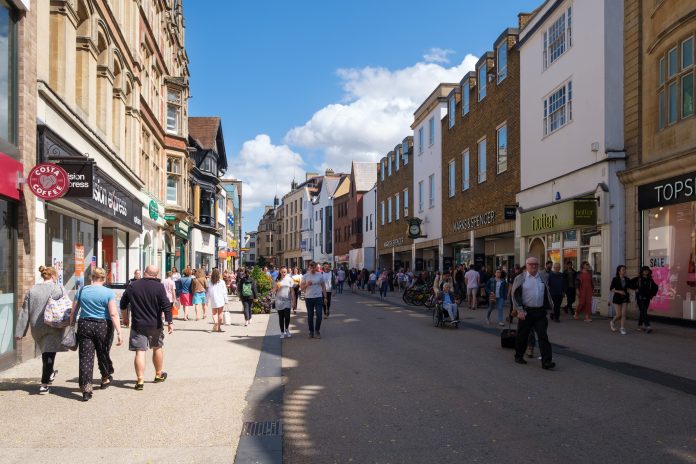Town centres already struggling with changing shopping habits and shifting footfall have been put under extreme stress by Covid-19. The road to recovery will depend on agile, data-driven decision making, says Steve Scott, executive leader of GHD Advisory UK
Over the last few years, the problems of viability in our city and town centres have been well publicised. The headlines have been dominated by the difficulties faced by retailers, but our high streets are much more than this – acting as hubs for work, services and activities on which our communities rely.
Their importance is emphasised by the fact that around one in six of the British population lives within 200m of a high street, and recent population growth in our centres has outstripped that in non-high street areas.
This decline in the fortunes of our city and town centres has been accelerated by Covid-19. But this accelerated decline is differentiated by the fact it is being driven by “behavioural” change, with the adverse economic impact being the outcome and not the cause.
The Covid-19 lockdown is challenging how we think about many aspects of our lives and our societal/behavioural ‘dials’ have been forced off the scale. The key questions for recovery are when, how and where the behavioural dial will reset.
Getting on the road to recovery
The road to recovery will take place in a context of constant change. The impact of Covid-19 on behaviours will develop over time: macroeconomic outcomes will depend on policy, stimulus and investment, while local economic success will depend on how we react to the change. However, short-term actions need to be formulated and immediate outcomes delivered post-Covid-19 to stimulate local economic recovery.
Our town and city centres will need to accelerate recovery, compete for new expenditure and footfall, and change the business model to align to new realities. Strategies will need to embrace change, partnership and dynamism.
In this context, the road to recovery needs to be agile, flexible and data-driven. Future strategies will need to be based on understanding behaviours, how they change over time and the impact this has on the economy. Strategy needs to take a more iterative approach to change and develop incremental steps towards a new future. Now is the time to transform the rule book and take a proactive approach to strategy that includes being:
- Data-driven: Strategy needs to be driven by new and immediate data, capturing change as it happens.
- Temporal: Change is constant, so strategy needs to be iterative, evolving and dynamic.
- Fiscally sustainable: Changing city centres means changing revenues. The business case and urban finance model needs to adapt alongside strategy.
The advent of the “agile strategy”
The agile strategy will be an ongoing process, based around continual insights, evaluation and response. The starting point is greater insight into the changing dynamics of the city infrastructure and assets. Combining complex datasets, mobile data and ‘real’ spend data provides more immediate temporal insights to accelerate understanding of impact and the ability to respond.
This will provide the basis for visioning new experiences and roles for our city centres, supporting the transition through small incremental steps as behaviours evolve. These visions need to be responsive to needs, rather than dictating expectations.
As relationships with a repurposed city centre change, so too will the infrastructure required to support it and the public sector financial model that sustains it – affordability and social value will be at the heart of this new future, as city centres balance new realities.
Actions to take to get ahead of the curve and prepare for recovery
As we move towards the recovery stage of the Covid-19 crisis, our cities and towns are starting the tentative steps to restricted reopening. They need to prepare to act quickly as this phase begins, starting with the development of an integrated understanding of change and impact. We believe there are three key actions that can be taken now to support a faster recovery.
-
Establish new data insights
Towns and cities are multi-million or billion pound economies but have historically made decisions using simple footfall data, one-off surveys or gut feeling. The current situation requires a far more comprehensive solution.
There is a need for detailed analytics that identify who is returning to city centres, how they are making their way around and where they are spending. The combination of traditional and complex datasets (including mobile data), provides immediate insights from which proactive interventions can be focused.
This data can be made available in a temporal (daily, monthly) based dashboard, allowing test and learn capabilities to help develop effective place, regeneration and marketing strategies.
-
Evaluate and monitor the impact
Before strategising and developing solutions, high streets need to understand how the insights will impact the economy, and the land use and infrastructure required. Currently, discussion of trends and impacts is speculative, with many different perspectives coming to the fore. Cities need to build strategies on certainty so that policies and initiatives developed create meaningful change.
In economic terms, demand curves have shifted, changing the market equilibrium and efficient provision. As data is gathered and shifts in demand are realised, modelling the supply implications and the response will be critical to delivering sustainable social value.
-
Define the strategy process
The agile strategy will be defined by an iterative process of data capture, evaluation, strategy steps, intervention and repurposing learnings. These process components will be enacted in different cycles across the recovery as behaviours and interventions take effect, but also as priorities and objectives change. We’ll see a shift from initially supporting business reopening and providing stimulus to establishing a longer-term future for our city centres.
The evolution of the flexible and temporal-based strategy will need to be controlled so that stakeholders and actors involved have clear transparency, and business cases to support interventions and investment (from both private and public sectors) are robust and justified.
Steve Scott
Executive leader
GHD Advisory UK
Twitter: @GHDspeaks
LinkedIn: GHD














